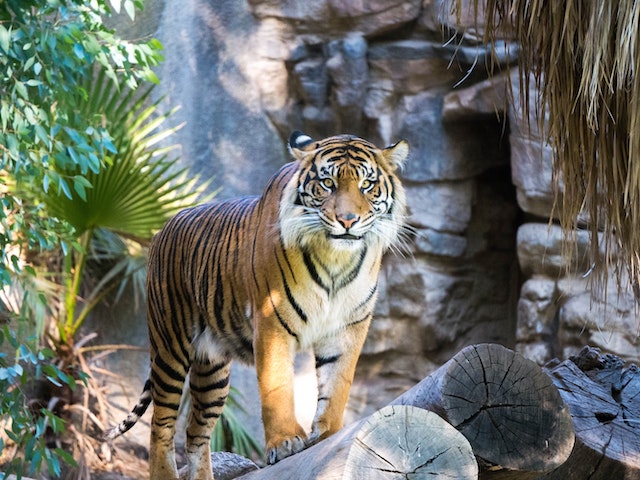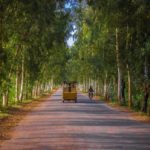Searching for the Real Life Bengal Tiger

The aggressive squawking woke me from my slumber. I opened my eyes and peered drowsily at a dark net surrounding me. Was I enveloped in a dream or on the set of a film-noir? I groped out of bed, unable to recall where I was until my feet hit the cold floor. I shook the mosquito net off of my shoulders and shuffled to the window.
The sky was still a pale silver-pink when I opened the wooden shutters, but the sound of happy screeches surged into the room. I squinted up at the towering silhouette of dark trees gently swaying in the morning breeze. Macaques cascaded from the heights, easily gliding from branch to branch. It was their excited calls that had awakened me.
Any moment now I might see amber eyes burning bright in the forests ahead.
I was at a safari lodge in Ranthambore National Park in Rajasthan, India. My reality still felt like a movie scene as the chill air wafted the scent of camellias and jasmine into the chamber. I sniffed excitedly and turned to prepare myself for my mission. I had only three hours to find one of the most magnificent personalities in the world: the Bengal tiger.
Ever since reading Jim Corbett’s Man Eaters of Kumaon, I have been fascinated with the lore of these elusive jungle creatures. While spending years in the wilds of Uttar Pradesh, Corbett wrote fascinating accounts of the beasts and their interactions with local villages. Repeatedly perusing them, I would picture myself walking the dusty village roads with him, hiding in ambush underneath the tessellated jungle foliage, lying in wait for the man eaters. His thrilling stories were the reason I rearranged my India trip for an overnight stay and single safari tour at Ranthambore.
Getting to my destination was a farcical experience, approaching the likes of a “Road to Morocco” vignette. I was sick before my early morning departure from Delhi. Once on the road to the park, the 362 kilometer drive (225 miles) was an endless stream of honking horns and backseat sweat as we inched through the clogged roads and dirt tracks of northern India.
When I finally arrived after sunset to Ranthambore, the humming crickets and flickering fireflies were a welcome contrast. Thankful for the cool darkness surrounding the lodge and a clean bed, I immediately fell asleep, unbelievably exhausted. That night I dreamed I was tracking Bengals with Captain Corbett among the lush forests and grassy plains of Ranthambore.
Searching for the Real Life Bengal Tiger
Since my time was severely limited, I was eager to make every moment count on my three-hour safari ride. Ranthambore reserve covers an area of 1,300 square kilometers (502 square miles), but the park is home to less than 50 Panthera tigris. This means that the chances of spotting one of these beauties is rare. My chances were scarcer since I only had one safari tour in which to catch the evasive monarch. I knew that long before I arrived at the reserve, but my hopes were pinned high. Images from Corbett’s exploits entwined with Kipling’s short story, “Tiger! Tiger!” flitted through my mind. To increase the chances of a sighting, the park had scheduled my tour at first light when the stealthy cats come out to hunt.
I hurriedly finished my breakfast of poori, chole, and spicy cucumber salad. Black faced langurs jauntily waved their tails, playing tag with each other on the front verandah as I ate. I would have loved to join them, but I had a more important task at hand, since my ride was here. My expedition was about to begin! I shook hands with the friendly driver and tracker and climbed aboard the open top jeep. Four other guests from the park glanced sleepily at me from the back seat as I joined them on our early morning adventure.
Any moment now I might see amber eyes burning bright in the forests ahead.
As we left the lodge for the main gates, I asked about the prospects of seeing the famed character. The tracker smiled and reassured me that the morning weather being cool and mild was a propitious sign for us. I returned the smile, exuberant, and leaned forward in my seat as the jeep entered a low stone wall through a grand archway. A pair of proud peacocks, their feathers in glorious display, greeted us at the entrance way and I felt it was another promising omen.
We were finally inside the domain of Ranthambore’s sovereign. Any moment now I might see amber eyes burning bright in the forests ahead. As we began our journey through open road, the sky broke into a coral shade while tiny babblers whirled over our heads, chirping gaily. The air felt invigorating and sitting at the end of the back seat I had only to reach out my hand to touch the tips of branches that brushed past our jeep. This was no imaginary setting in a book or film location. Instead, I was exposed to a true wilderness and I felt intoxicated by the experience.
Rapidly the forest closed in and the jeep was wrapped in a thicket of branches. Muffled sighs and groans issued from the gnarled twigs; the whole area seemed to be waiting for something. I started as a sudden rush of wings took flight and waking birds cried out sharply. I looked around for signs of a striped back, but the driver grinned amusedly and explained that it was the noise of the jeep that caused the birds to raise the alarm.
This was no imaginary setting in a book or film location. Instead, I was exposed to a true wilderness and I felt intoxicated by the experience.
As we wended our way into a quiet cove, I spotted a flash of amber colored hide. The jeep stopped in its tracks and my heart skipped a beat. Was it a tiger? Seconds later a graceful sambar, its swirling antlers reared high, stepped into the clearing. It wasn’t our quarry, but I marveled at its majestic pose. We continued on, thick trees giving way to short brush and less cover. I gasped when a stifled movement caught my eye. Did I just spot a marbled hue in the undergrowth? Yes, but it was a black francolin who trotted off through the grass, indignant at our approach. My ultimate encounter was being paved by an introduction to the reserve’s other magnificent creatures.
Eventually, we came upon the tenth-century ruins of a fort overlooking the park expanse. Long ago, rajas spent lazy summer afternoons relaxing here after a day of hunting. Today the palace, along with a handful of scattered kingly pavilions, gives the reserve an air of antiquated beauty. During our brief rest stop, I climbed one of the smaller ramparts to survey the scenery. The landscape unfolded from thick forest to grassy plains with smooth lakes beyond. I scanned the expanse, but saw no glimmer of black-and-tawny stripes. The vista was stunning, yet I knew the highlight for me would be a sighting of its scant and evasive ruler.
Searching for the Real Life Bengal Tiger.
The safari tour was almost over. We had spied a number of civets, monkeys, and deer. I had learned to identify the paw print and scent of my prey, but we had not spotted a single wild cat. It seemed the slippery hunter wanted to display its presence without being seen. I felt exhausted because the jeep ride had been a roller coaster for my emotions.
Suddenly, a call came through to the driver from his CB radio; we roared towards the entrance gates. Arriving in record time, we parked in the middle of the road and shut off the engine. Everyone in the jeep surveyed the area with nervous energy. Were we too late? Did we miss our best and last opportunity to espy our treasure? I stood up in the back of the car for a better glimpse as a heavy stillness fell. Then, pushing forth from the corner of a bush a majestic brute sauntered towards us, its head swinging from side to side. The animal paused 4 ½ meters (15 feet) away from us and raised its head. I was looking directly into the golden eyes of a Bengal tiger!
Mesmerized, I could not look away from its stare. My fingers gripped the top of the jeep door like a vise. The two of us locked gazes and time seemed to have stopped still for me; nothing else existed. In reality, only a few moments passed before the quarry turned away. Unconcerned, he moved fluidly back into the shade of the black forest depths.
I realized I had held my breath and let it out, shaking. With the tiger’s disappearance, my heart gave a painful thump and began to beat again. The sound of birds calling returned to the forest. I sank back down inside the jeep overwhelmed. A brief glance from this formidable beast had transfigured me in an instant. Throughout my safari, I had been engrossed in the thrill of the unreal. Though I had no rifle in hand, my obsession with Corbett’s tales had overtaken my senses and colored my jeep ride.
When the raw power of the beast had scrutinized me, I realized I had underestimated the potential of this life experience. This was an encounter that was immeasurably richer than any I had read in books or seen on film. It was my narrative, a deeply personal first person chronicle that only I could fully appreciate. For many years, I had succumbed to the lure of Jim Corbett’s storied tigers. Now I had fallen under the spell of a flesh-and-blood meat eater of Ranthambore.
I had relied on anecdotes on the printed page and the silver screen to mold my thought patterns, but it became clear to me that travel was the opportunity to live some of those fictional episodes.
When the feline’s glance seared through me, I understood the encompassing impact of travel. I was electrified by the idea that every future journey I took would be marked by moment
s such as this. Tangible incidents that would transform me as a person and shift my entire outlook. I had relied on anecdotes on the printed page and the silver screen to mold my thought patterns, but it became clear to me that travel was the opportunity to live some of those fictional episodes.
I yearned for my next intimate encounter, my subsequent adventure, one which I no longer had to envision but could face. In the wilderness of Rajasthan, I had shed the cloak of make-believe and taken up an intrepid escapade. I do not know what future expeditions lie ahead of me, but I am certain that they will all be more intoxicating than any I have read.
Top photo credit by Unsplash.








